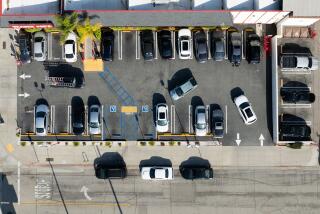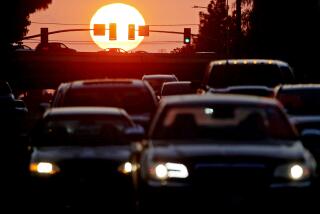Grinding Gridlock : In Bangkok, It’s Life in Slow Lane
- Share via
BANGKOK, Thailand — As a radio barked overhead, Sgt. Komart Plongkong, looking militarily precise in a gray uniform with a chest full of campaign ribbons, punched a button on the console in front of him, blew a nickel-plated whistle and waved his arm with the casual assurance of one accustomed to giving orders.
Suddenly the ground began to tremble, and there was a deafening roar. The air boiled, filling the tiny command post with acrid black smoke.
Komart, a veteran traffic cop, stood scowling at the corner of Silom and Rama IV roads, struggling to tame the whining, recalcitrant, rush-hour throng.
At Komart’s command, a line of motorcycles sounding like chain saws spilled into the intersection, followed by three-wheeled taxis called “tuk-tuks” because of their sputtering engines. A huge backlog of cars, buses and trucks stretching through the financial district snaked briefly forward and then shuddered to a halt.
‘Worst Corner in City’
“This traffic is unbelievable,” Komart said wearily. “This is the worst corner in the city. It’s so bad you can’t work here all day. You have to get away from the pollution and the noise. It will make you sick.”
Other cities have traffic problems, but for sheer gridlock, noise and exhaust pollution, there are few places that compare to Bangkok, where the cars are virtually wall to wall, a city literally stuck in traffic.
The congestion is so fearful that a seller of luxury European cars on Sukhumvit Road, one of the most clogged thoroughfares, is promoting a special device called a “chassis dynamo-meter,” which allows prospective car buyers to simulate highway speeds in the showroom rather than face the bumper-to-bumper nightmare outside.
“On this sophisticated equipment,” an ad boasts, “a car can go full speed standing still.”
Noise and Pollution
A Western diplomat, soon to retire, told a recent visitor that he and his family had faced war, terrorism and other dangers but could not cope with the traffic noise and pollution of Bangkok.
An American homemaker who lives here echoed his complaint. “There are days,” she said, “when you just don’t want to go out in it.”
According to government statistics, there are 1.7 million motor vehicles registered in Bangkok, and the number is increasing at the rate of 300,000 a year. Only 9% of the city’s surface area is covered by streets, compared to 25% in Los Angeles.
As a result of these two converging statistics, the average speed on Bangkok streets is slightly less than 7 miles per hour.
“What this city needs is birth control for cars,” Maj. Gen. Kiattisak Prabhavat, commander of the Bangkok police force’s 4,000-man traffic department, jokingly told an interviewer.
In many ways, Bangkok’s traffic woes reflect the darker side of the country’s economic success story. Thailand has joined the ranks of Asia’s other economic “tigers” in recent years; for the past three decades, annual growth has averaged more than 6%, and last year it was 11%.
The rapid economic growth has caused Bangkok’s population to swell to nearly 6 million. In addition to Thais streaming into the city looking for work, Bangkok has become a magnet for Western and Japanese business people looking to expand in Asia--and this has sent real estate prices skyrocketing.
As a result, Thailand’s traditional gabled teak homes are giving way to 18-story office buildings and condominiums with rainbow-striped balconies and ersatz Greek temples for penthouses. One longtime resident recently counted more than 100 high-rise buildings going up in the city center, where there are no zoning laws.
“The traffic system is at the oversaturated stage and is very unpredictable,” said Somchet Taeracoop, director of the city’s urban development coordination division. “The rush hour used to begin at 8 a.m. Then it was 7 a.m. Now you have people lining up for a bus at 6 a.m. If there is a traffic accident now, it can bring the whole city to a standstill. It’s very worrying.”
‘Venice of the East’
Bangkok, which is not yet 200 years old, was designed around the Chao Phraya River. The network of canals, or klongs , as they are known locally, earned Bangkok the sobriquet “Venice of the East.” Today, the fastest way to get through the city is still by water taxi, a graceful, long-nosed wooden boat resembling a gondola with a truck engine mounted at the rear.
As the city sprang up around the klongs , the passageways between the houses remained narrow--in some places less than the span of a man’s arms. When streets were gradually introduced, they were equally narrow.
“The city wasn’t designed for cars,” said Maxine North, an American who arrived in Bangkok in 1950 and later introduced bottled water to the country. “When we arrived there were hardly any cars, but there was traffic. The streets were so narrow--you had a klong on either side--that you couldn’t even pass. Most people traveled by samlor. “
The samlor (literally, three-wheels) was a cab driven by pedal power. They were so slow that eventually they were outlawed and have been replaced by the tuk-tuks.
There are more than 7,000 tuk-tuks on the streets of Bangkok, and they charge about half of what the regular taxis charge. The tuk-tuk is a hybrid, part car and part motorcycle, that resembles a golf cart in looks and doubtful stability. It has a bench seat in back, a thin roof overhead and motorcycle handlebars for the driver. It is powered by methane gas, and photos of tuk-tuks lying charred by the road appear from time to time in the local newspapers.
Because the streets are so narrow, the most popular form of transport is the motorcycle, of which there are more than 775,000 in Bangkok. No plaything of the affluent, they can be seen transporting families of five, or huge piles of goods.
To increase the power of their tiny engines, many drivers simply saw off the mufflers. The result is deafening noise.
A great deal of the city’s daily life is carried out along the streets, and this adds to the congestion. Along the tiny sois, or side streets, shoes and clothing are sold from cardboard boxes by aspiring entrepreneurs. Bands of blind musicians compete for space with mango peddlers. Makeshift restaurants dot the curbs and spill into the streets, with vendors serving tiny pancakes and deep-fried spare ribs from curb-side pushcarts.
A large truck is all it takes to clog a side street for an hour, as a chorus of police officers blowing frantically on whistles try to extricate the vehicle.
Five years ago, in an effort to clear up the mess, the traffic police introduced a system of one-way streets. This helped for awhile, but now the traffic has gotten so out of hand that police are seeking to have the old two-way system restored.
“It’s so congested that vehicles can hardly move,” said Maj. Gen. Kiattisak, the traffic police commander.
Congestion is also caused by construction, he said, and by the water and power companies’ tearing up of the streets.
“You have to admire us for getting the traffic moving at all,” Kiattisak said.
Discourteous Drivers
As in England, Thai drivers use the left side of the road, but motorists have not mastered the British art of politeness behind the wheel.
“The drivers are very impolite,” Kiattisak said. “They have no regard for other people. They are very selfish. They are always trying to commit a traffic offense whenever they can get away with it.”
Somchet, who plans traffic solutions for the urban development department, said that while there are several potential answers to the traffic problem, such as car pools and limited entry to the city center, the city must first expand its mass transportation system to offer commuters an alternative to driving to work.
At the moment, mass transit in Bangkok consists of a fleet of 4,500 buses, of which one-quarter are more than 12 years old and badly maintained. The fare is 10 cents. The government hopes to sell many of the buses to Vietnam, which has hardly any vehicular traffic, to help pay off the Bangkok Metropolitan Transportation Agency’s $320-million debt.
New buses are on order from Europe, and officials hope they will help bring down Bangkok’s appalling level of air pollution, which is attributed almost entirely to cars, buses and trucks.
Suthirak Sujaritanonta, an expert on air quality, said in an interview that virtually every day sees air pollution exceeding permissible norms in some parts of the city, usually where traffic has been stalled for hours.
Bangkok had a tramline in the early part of the century, but it was torn up in the 1950s. Now, a private consortium is raising funds to build a “sky train,” an elevated rail system that would considerably ease congestion on streets entering the city from the east and the north, the biggest problem areas. But it will take at least seven years to build it.
Bangkok’s traffic improved considerably with the completion of a toll-road expressway from the airport through the city center. Its major drawback: Heavy trucks that might otherwise bypass the city must pass through the middle of the city. But the expressway will soon be joined with a “ring road” designed to carry trucks away from the city center.
“We’re not predicting an improvement in the traffic,” Somchet said glumly. “We’re just trying to keep it from getting worse.”
More to Read
Sign up for Essential California
The most important California stories and recommendations in your inbox every morning.
You may occasionally receive promotional content from the Los Angeles Times.











